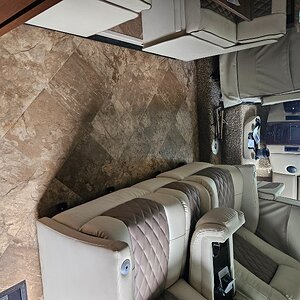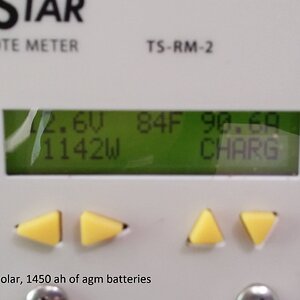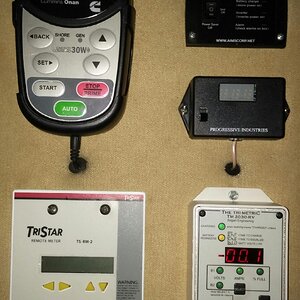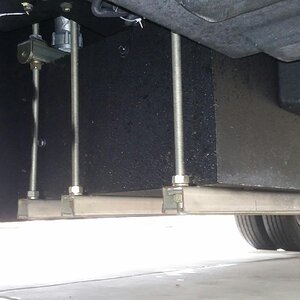Neal
Administrator
- Joined
- Jul 27, 2019
- Messages
- 13,871
- Location
- Midlothian, VA
- RV Year
- 2017
- RV Make
- Newmar
- RV Model
- Ventana 4037
- RV Length
- 40' 10"
- Chassis
- Freightliner XCR
- Engine
- Cummins 400 HP
- TOW/TOAD
- 2017 Chevy Colorado
- Fulltimer
- No
BMS - Battery Management System
Let me start by saying I'm not an expert, I simply just had a LiFePO4 upgrade done by Solar Energy Systems in Nappanee, IN. I went down a path that involved making a decision on internal vs. external BMS. Initially my plan was minimal, drop in LiFePO4 batteries of some brand, type, size into my Victron solar setup with Magnum 2812 inverter that came with the coach. I had various Victron elements such as Venus GX, BMV 712, etc. so the plan was to keep as much as possible and minimize cost. Well, we all know how that ended up
Initially my point of contact at SES advised against external BMS due to concerns if something goes bad in a battery it will shut the system down. That's sort of true, as with what happened to me yesterday it saw temps below the threshold and inhibited charging of one of the Victron LiFePO4 300ah smart lithium batteries as there are limits for current going in (charging) and coming out (discharging). Discharge has a pretty wide temperature span, below 0F and high temp but charging is more restricted such as 32F with a safety margin I learned of yesterday to 41F. That's not that cold and charging is inhibited. Not a big deal, most of us are plugged in typically anyways.
Now the direction initially may have been marketing related, the biggest profit is going to be on their home made batteries with internal BMS. I decided on day 1 of my install to go with my gut and dream which was all Victron which drove me to external BMS. I believe in the quality of the product and with proper care all will work fine, as it has to date.
I'd say MOST of the LiFePO4 installs in the RV world typically by DIYers is going to be internal BMS in the batteries and there is nothing wrong with that. The moral is that if you have an external BMS then you have an electronic component that is the brain of the system and will manage everything. If you have an internal BMS then YOU are the brain of the system, you have to manage this and understand what's going on. The battery will of course do what it needs to in order to protect itself which is the purpose of the internal BMS but if you want functionality of your batteries, you can't just fallback to letting things shutdown for protection, you ideally want to be using your batteries at all times. So with that said, understand the limits and design for them. As my other thread states - HEAT is pretty much a must have item for these batteries unless you know you will never be in climates below 40F. Even in a sealed bay with a vent from other bays, you're likely to be near ambient temps +/- 10F I'm guessing. My bay is insulated with spray foam and backing boards, gasket sealed, and temp monitored.
So again, there is no right/wrong way to setup your system, just realize the differences in computer controlled battery management "external BMS" vs. manually controlled (you) with internal BMS batteries.
Let me start by saying I'm not an expert, I simply just had a LiFePO4 upgrade done by Solar Energy Systems in Nappanee, IN. I went down a path that involved making a decision on internal vs. external BMS. Initially my plan was minimal, drop in LiFePO4 batteries of some brand, type, size into my Victron solar setup with Magnum 2812 inverter that came with the coach. I had various Victron elements such as Venus GX, BMV 712, etc. so the plan was to keep as much as possible and minimize cost. Well, we all know how that ended up
Initially my point of contact at SES advised against external BMS due to concerns if something goes bad in a battery it will shut the system down. That's sort of true, as with what happened to me yesterday it saw temps below the threshold and inhibited charging of one of the Victron LiFePO4 300ah smart lithium batteries as there are limits for current going in (charging) and coming out (discharging). Discharge has a pretty wide temperature span, below 0F and high temp but charging is more restricted such as 32F with a safety margin I learned of yesterday to 41F. That's not that cold and charging is inhibited. Not a big deal, most of us are plugged in typically anyways.
Now the direction initially may have been marketing related, the biggest profit is going to be on their home made batteries with internal BMS. I decided on day 1 of my install to go with my gut and dream which was all Victron which drove me to external BMS. I believe in the quality of the product and with proper care all will work fine, as it has to date.
I'd say MOST of the LiFePO4 installs in the RV world typically by DIYers is going to be internal BMS in the batteries and there is nothing wrong with that. The moral is that if you have an external BMS then you have an electronic component that is the brain of the system and will manage everything. If you have an internal BMS then YOU are the brain of the system, you have to manage this and understand what's going on. The battery will of course do what it needs to in order to protect itself which is the purpose of the internal BMS but if you want functionality of your batteries, you can't just fallback to letting things shutdown for protection, you ideally want to be using your batteries at all times. So with that said, understand the limits and design for them. As my other thread states - HEAT is pretty much a must have item for these batteries unless you know you will never be in climates below 40F. Even in a sealed bay with a vent from other bays, you're likely to be near ambient temps +/- 10F I'm guessing. My bay is insulated with spray foam and backing boards, gasket sealed, and temp monitored.
So again, there is no right/wrong way to setup your system, just realize the differences in computer controlled battery management "external BMS" vs. manually controlled (you) with internal BMS batteries.












